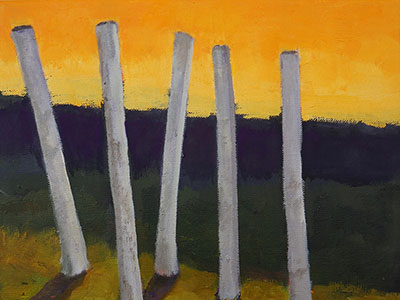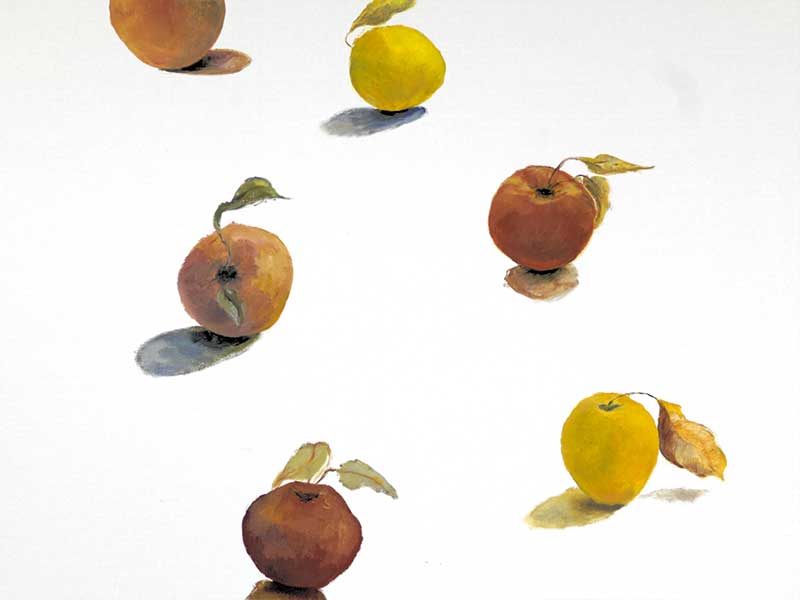David Blake, poet (1996)
Four years ago, when I was asked to define my feelings about theresa rijssenbeek’s artistic achievement I was immediately struck by the interplay of poetry and rhythm; sensuality and lyricism. The synopsis suggested that a tension was afoot, unresolved as yet, but brooding behind the elements of darkness and light and the juxtaposition of colour and form.
Nonetheless, an endless and changing array of poetry and light prevail. The new canvases; far from the casual and transitory implications of the subjects, have always a gripping lyricism. A precisely delineated flattened form and softly hewn colour are becoming an integral part of her method. It seems that as her ideas clarify in these related works, the need to compress space is a clear force, in a way akin to the modern concept of flat space, evoked in an early Matisse or the 1922-1926 still-life period of Picasso.
Whether or not her paintings have symbolic meanings is open to conjecture, but certainly the latest paintings especially ‘on lines’ and ‘connected worlds, loose ends’ suggest a strange, nether region of the subterranean fantasy. The mood is the emanation of a sensitive state of mind; inquiring yet restless, and in ‘natural lines, natural flows’, the four sketch like figures might be suggesting transcendent spirituality. Beside her depth of colour, the light and singing hues of her palette seem like a soprano part. It is striking that the writer has noticed the importance of both structural form and mood, the continuance of lyrical colour and the coexistence of feelings of reserve and contemplation, and thus has perceived salient features of a mature style in these latest paintings.
Maybe the formal and highly rational order of her Mexico inspired paintings is being replaced by the fantastic, the accidental, the illogical. Perhaps the unconscious is the essential source of her art, the inner universe of the imagination, rather than the external world – become the wellspring of all inspiration. In the light of John Graham’s, ‘System and Dialectics of Art’, I quote, “The purpose of art in particular is to re-establish a lost contact with the unconscious, with the primordial racial past and to keep and develop this contact in order to bring to the conscious mind the throbbing events of the unconscious mind.”
Paintings like ‘dreams to remember’, ‘intersection’ and ‘white fever’ are stratified in composition, sometimes divided into sharply differentiated registers. Images are disposed in an orderly, geometric manner and at times are segregated into zones. However, in ‘focus facility, lost focus’, which I consider her strongest painting, the colour zones seem to be less systematically compartmentalized, and by painting a rather free-form grid across the surface, seemingly at random, she isolates the images thus enhancing its emotive powers.
Theresa rijssenbeek purifies her art by rejecting the decorative qualities of paint, by ridding her canvases of complex relationships of colour, form and structure. She reduces colour to its essence and makes it become volume, form, space and light. Having emptied her paintings of the superfluous, she is able to express both the material reality of abstract painting and the incorporeal reality of the sublime. This process of simplification which I have noticed in the last four years heralds an act of revelation, even of exaltation, an embodiment of the artist’s personal truth and conviction.
Philosophically it seems as if theresa rijssenbeek is limiting her forms and restricting her number of colours; perhaps her intention is to enhance rather than reduce the expressive possibilities of her painting. To suggest multiple levels of meaning she is stripping away extraneous detail. Once this purification has occurred and imagery has been renovated, the viewer is permitted new kinds of associations, in Apollonaire’s words, “numerous interpretations that sometimes contradict each other”.
David Blake, The Hague, The Netherlands 1996

















































































 Born in the Netherlands, 1951, theresa rijssenbeek spends a large part of her youth near the North Sea coast. Dunes, woods and the sea are the setting of her early life. She draws what she admires. When she lives for three years on the tropical island of Curacao (late 70’s) she is overwhelmed by the colours and nature. She starts painting using oil and water paint. Her first exhibition is a great success. Back in the Netherlands she studies at the prominent Royal Academy in The Hague and becomes lifelong friends with head of department Rien Bout who also coaches her. Her professional career as a painter begins in 1990, with yearly exhibitions. The city of Delft commissions a 10 metre high mural painting in a housing project. Not much later, theresa’s work is also seen on Dutch television.
Born in the Netherlands, 1951, theresa rijssenbeek spends a large part of her youth near the North Sea coast. Dunes, woods and the sea are the setting of her early life. She draws what she admires. When she lives for three years on the tropical island of Curacao (late 70’s) she is overwhelmed by the colours and nature. She starts painting using oil and water paint. Her first exhibition is a great success. Back in the Netherlands she studies at the prominent Royal Academy in The Hague and becomes lifelong friends with head of department Rien Bout who also coaches her. Her professional career as a painter begins in 1990, with yearly exhibitions. The city of Delft commissions a 10 metre high mural painting in a housing project. Not much later, theresa’s work is also seen on Dutch television.


















